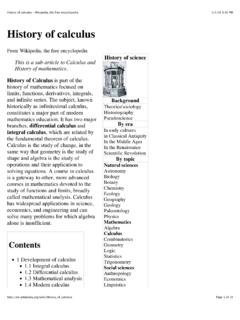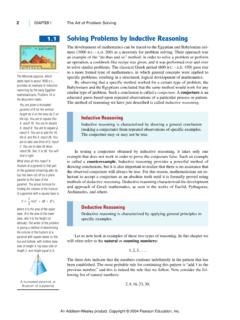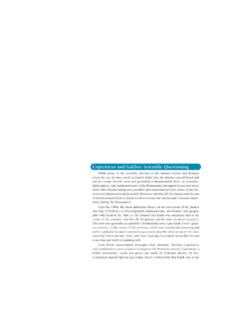Transcription of Curriculum models: product versus process
1 Journal oj Advunced Nursing, 1986,11,671-678 Curriculum models: product versus process John Sheehan MSc MEd DipFE SRN RMN RNT FRSH Principal Lecturer in Nursing, Faculty of Education, The Polytechnic, Holly Bank Road, HuddersJeld HD3 3BP Accepted,for publication I7 January 1986 SHEEHAN J. (1986) Journal ofAdvancedNursing 11,671-678 Curriculum models: product versus process At the beginning of this article there is a brief outline of the nature of the Curriculum and models. This leads into a discussion of Curriculum models in which product and process models are set out and discussed. The strengths and weaknesses of both approaches to the Curriculum are outlined and issues relating to the choice of model are advanced. INTRODUCTION When we reflect on the nursing Curriculum we ought to keep a number of things in our thoughts. There are the needs of individual patients and how these might best be met, and there are the needs of the nursing students.
2 Beyond the individual, there are societal needs; the need for an efficient and a humane nursing service. Coupled with this is the need for skilled manpower to provide this service. There are also vocational aspects. Vocational is taken here to mean fitted for the task. To be fitted for the task of nursing means having a store of relevant knowledge, supported by a foundation of science and a motive of service, and the ability to apply this knowledge in a variety of circumstances. It means using this knowledge in an ethically acceptable way which embodies respect for persons. And it also means an understanding of the ethos, mores and values related to nursing; in other words it means going through a process of socialization. In this paper it is proposed to examine two approaches to the Curriculum (the product and the process ) in relation to the education of nurses. But first it is necessary to deal with the key concepts of curricula and models.
3 *This paper is based on a paper presented at a West Midland Regional Health Authority Workshop on Curriculum develop- ment, November 1985. KEY CONCEPTS There is a plethora of definitions of the curricu- lum. Those by Tyler (1949), Neagley & Evans (1 967), Inlow (1 966) and Johnson (1 967) are but a few examples. However, the definition which it is proposed to use here is the one by Stenhouse (1975). A Curriculum is an attempt to communicate the essential principles and features of an educational proposal in such a form that it is open to critical scrutiny and capable of effective translation into practice. There are a number of features of this defi- nition which make it attractive. The first is the concentration on essential principles; this should avoid getting lost in a mass of detail likely to cloud the issues. A Curriculum ought to be reviewed and subjected to critical scrutiny from time to time. That it should be capable of being translated into practice is a fundamental require- ment since this must be regarded as the acid test for any educational proposal relating to a vocation.
4 According to Page & Thomas (1 977) a model is a means of transferring a relationship or process from its actual setting to one in which it can be more conveniently studied. Fawcett (1984) suggests that the term con- ceptual model, and synonymous terms such as conceptual framework and conceptual system, 67 1 672 J. Sheehan refer to global ideas about the individual groups, situations, and events of interest to a discipline. According to Lippett (1973) conceptual models have existed since people began to think about themselves and their surroundings. He identified examples of models in the early egyptian and Chinese civilizations and in disci- plines such as physics, medicine, mathematics , chemistry and biology. Lippett (1973) made the point that models were influential in shaping the world. Examples given in this context were Marx & Engels (1968), Einstein (1950) and Sigmund Freud (1914). Marx's model related to political, philosophical, social and economic matters and provided a framework for communist ideology.
5 Einstein's model of relativity paved the way to the atomic era. Freud's model provided a structure for the understanding of man in the context of psychoanalysis. MODELS OF THE Curriculum The Further Education Curriculum Review and Development Unit. London (FEU 1980) has set out seven variants of Curriculum models and these are set out in Figure 1. Each model is based on certain assumptions about the students for whom it is designed. In the first place the deficiency model is based on the assumption that the students have learning deficiencies which need to be corrected before progress can be made. The deficiencies may be in the areas of literacy, numeracy. inter- personal or manipulative skills. On the other hand a deficiency may relate to a student's self- image or a lack of recognition of his learning needs. The competency model, as its name suggests, is concerned with the 'acting' part of learning in the form of performing specific skills. Practical nursing skills would be considered in this context A model which may be described as information-based would be concerned with the acquisition of knowledge such as the knowledge needed for a nurse to function in an informed and in an understanding manner.
6 In a sense all education is information-based, but this model highlights the acquisition of knowledge rather than other aspects of the educational process . Socialization, as its name implies, is concerned with the initiation of the student into the social milieu of nursing. It is characterized by the development of attitudes and values, and assumptions about the requirements of the world of work, vocational matters and society. The four models which have just been described rather briefly are all product models, that is, the emphasis is placed on the outcome of a learning experience. The next group of models to be considered are all process models. In this context the emphasis is on learning acquired from experience of work and life, that is experiential learning. It comprises open-ended student activities with developing tendencies and capacities. The emphasis is on the quality of the learning as it takes place rather than on predetermined outcomes. The reflective model is an example of a process model.
7 The essence of this model is developing in the student the capacity to look at experience or data in alternative ways. It is concerned with working out possible relationships between matters being studied, making generalizations and the development of conceptual frameworks by the student. Reference to Figure 1 shows that the reflective model is mainly concerned with the 'knowing' aspect of learning, but it is also concerned with the feeling aspect. Finally, as far as Figure 1 is concerned, there is the 'counselling model'. This model is mostly concerned with the 'feeling' aspect of learning. This model is characterized by a concern with understanding and control of personal behaviour and that of others. Counselling is sometimes described as a helping relationship, that is, helping the person to know himself/herself better. It allows feelings to be expressed. This is particularly important in a case where feelings may be acting as a barrier to learning.
8 product MODEL The FEU (1980) represents the product model of the Curriculum as leading to some kind of desirable end- product . Examples given are knowledge of certain facts, mastery of specific skills and competencies, and acquisition of certain 'appropriate' attitudes and values. Among the Curriculum theorists in the product mode are Bloom et al. (1956), Gagne (1967), Curriculum models 673 Acting Knowing Feeling product FIGURE I Models of the Curriculum reproduced with permission of the Further Education Unit. Kerr (1968), Krathwohl et al. (1969), Mager (1962), Tyler (1949) and Wheeler (1967). Behavioural objectives provide the founda- tions on which product models of the Curriculum are built. The intended outcome (the product ) of a learning experience is prescribed beforehand. There are points for and against behavioural objectives and thus the product model of the Curriculum . Rowntree (1974), for example, argues that the use of behavioural objectives facilitates communication of what is intended and therefore leads to more purposeful learning.
9 He also argues that the use of behavioural objectives helps with selection of structure and content of teaching; he further argues that behavioural objectives lead to more accurate methods of testing and evaluation. One of the early critics of behavioural objec- tives was Eisner (1966). He conceded that while the objectives approach is a rational one it does have its weaknesses. A point of contention is that educational outcomes are often unpredictable and are therefore impossible to specify before- hand. Eisner (1967) argues that some subjects, the Arts for example, do not lend themselves to behavioural specificity. He further argues that behavioural objectives can become so numerous that a teacher could spend more time writing them than teaching. The key elements of a product model of the Curriculum are set out in Figure 2 and typically comprise objectives, knowledge, experience and Objectives Expeiience FIGURE 2 The elements of aproduct modelof the Curriculum .
10 Evaluation. However, examination of Figure 3 provides a different perspective. The individual is in the centre of the educational arena and is, to some extent, regarded as a receptacle for knowl- edge. What is to be learned is predetermined by others and the learner takes a passive role except for the processing of great masses of information coming at him from all directions. process MODEL The FEU (1980) depict process approaches to the Curriculum as being more open-ended than the product approach. Continuous development is emphasized and the outcome is perceived in 674 J. Sheehun FIGL'RE 3 The position of the sturfent on oprodutt model ofthe Curriculum . terms of the development of certain desirable processes and potentialities. The examples given are ways of thinking. acting and feeling, which the learner is able to use for his own purposes. The FEU (1980) document makes a further distinction between ' product ' and ' process '. The point is made that while learners may acquire knowledge as a product , that is, the results of the thinking of others.









